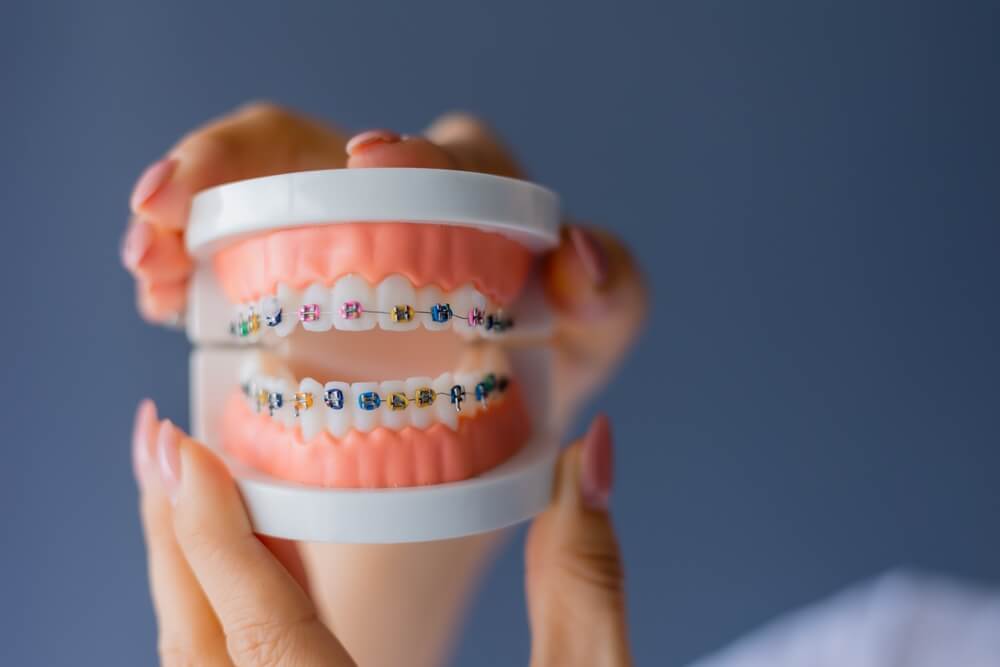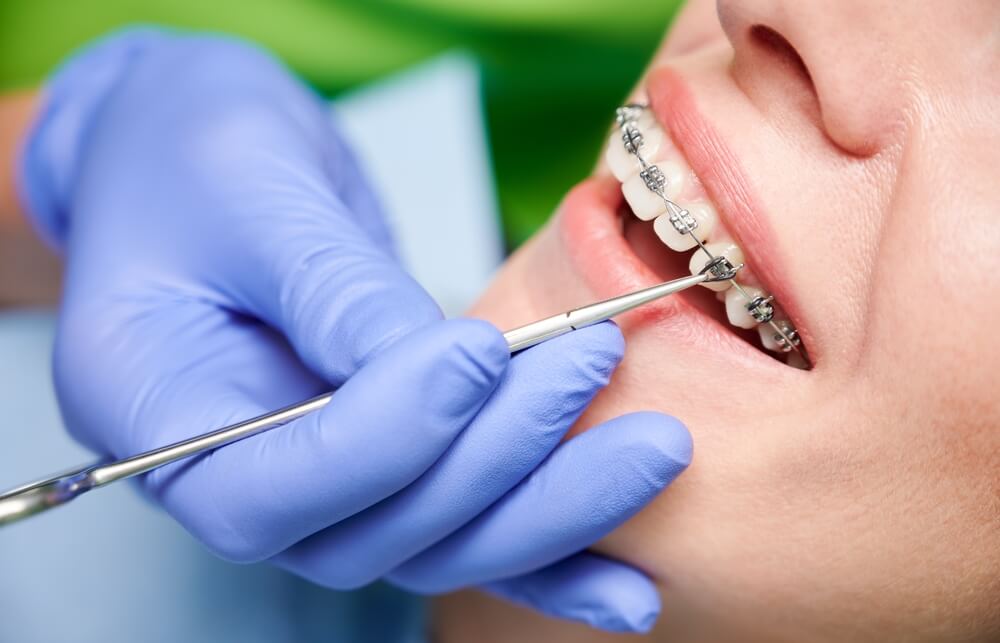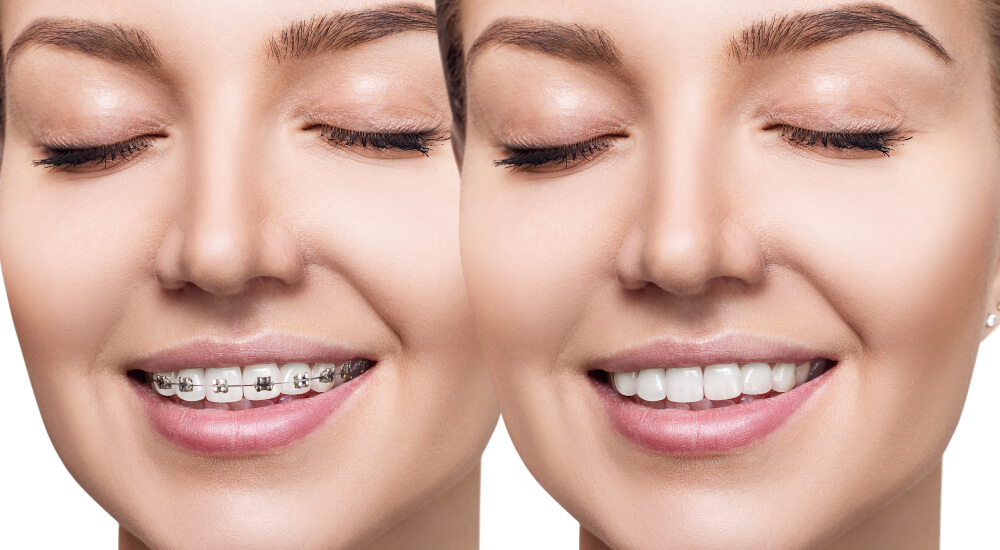Thinking about braces but missed the boat as a kid? You’re not alone! Adult braces are more popular than ever, and for good reason. Straight teeth aren’t just about aesthetics; they can improve your oral health and boost your confidence.
This guide jumps into everything you need to know about adult braces, from the types available to how long they take to work.
What are dental braces?

Dental braces are orthodontic devices used to gradually shift teeth into a straighter position. Braces consist of brackets bonded to each tooth, connected by wires or elastics that apply gentle, constant pressure. Over time, this pressure remodels the bone around your teeth, aligning them for a beautiful, healthy smile.
Different Types of Adult Braces
With so many options available, choosing the right type of braces can feel overwhelming. Here’s a closer look at each type to help you make an informed decision:
Metal Braces
The tried-and-true option, metal braces are highly effective in correcting a wide range of orthodontic issues. They consist of stainless steel brackets bonded to each tooth, connected by a thin metal archwire. Tiny elastic bands (ligatures) hold the wire in place and can be colored for a fun touch. Metal braces are the most affordable option, but they are also the most noticeable.
Ceramic Braces
Offering a more discreet alternative, ceramic braces function similarly to metal braces. However, the brackets are made from tooth-colored ceramic, making them less visible, especially when paired with clear or white elastics. While not completely invisible, they are a good choice for adults who want a less obvious treatment option.
Lingual Braces
For maximum discretion, lingual braces are placed on the backside of your teeth, facing your tongue. This makes them virtually invisible from the front. However, lingual braces can be more expensive and may require some adjustment time as they can cause slight speech impediments. Additionally, cleaning around lingual braces can be a bit trickier.
Aligners (Clear Aligners)
Aligners, like Invisalign, are a popular choice for adults seeking a near-invisible treatment option. These are clear, removable trays custom-made to fit your teeth snugly. Every few weeks, you switch to a new aligner tray that gradually shifts your teeth into the desired position.
Aligners offer the benefit of removability for eating, brushing, and flossing. However, they may not be suitable for all cases and require strict adherence to wear time for optimal results.
Self-Ligating Braces
Designed for efficiency and comfort, self-ligating braces use a clip or latch mechanism to hold the archwire in place instead of elastics. This reduces the need for frequent adjustments and may minimize discomfort associated with traditional elastics. Self-ligating braces come in both metal and clear ceramic options, offering a balance between effectiveness and aesthetics.
Power Chain Braces
While not a separate type of braces, power chains are elastics that connect multiple brackets on your teeth. They apply more targeted pressure to specific areas that require faster or more controlled movement. Power chains are often used in conjunction with traditional braces to accelerate treatment in certain areas.
How do braces work?

Braces work by applying gentle, constant pressure to your teeth. This pressure stimulates bone remodeling, causing the bone around your teeth to break down and rebuild in the desired position. Over time, your teeth gradually move into their new, straighter alignment.
Reasons Adults Might Need Braces
While crooked or misaligned teeth are the most obvious signs you might need braces, there are other factors to consider. Here’s a deeper dive into the signs that adult braces could be beneficial:
Crowded Teeth
This is a common issue, where there’s simply not enough space in your jaw for all your teeth to fit comfortably. This can cause them to overlap, rotate, or become pushed out of place. Crowded teeth affect aesthetics and can also make it difficult to properly clean your teeth, increasing your risk of cavities and gum disease.
Gapped Teeth
Excessive space between your teeth can be caused by missing teeth, a large jawbone, or abnormal tooth development. Gaps can affect your bite and speech, making certain sounds harder to pronounce. Additionally, food can easily get lodged in the gaps, increasing your risk of cavities and gum problems.
Malocclusions (Bad Bites)
This term encompasses various bite problems, including overbites, underbites, crossbites, and open bites. Overbites and underbites occur when your upper or lower front teeth protrude excessively.
Crossbites happen when your upper and lower teeth don’t meet properly when you bite down. Open bites leave a vertical space between your upper and lower front teeth when you close your mouth. Malocclusions can affect your appearance and lead to difficulty chewing, jaw pain, and even TMJ (temporomandibular joint) disorders.
Difficulty Chewing
Misaligned teeth can interfere with your ability to chew properly. This can lead to digestive problems and place excessive strain on your jaw muscles, potentially causing pain and discomfort.
Uneven Tooth Wear
If you notice uneven wear and tear on your teeth, it could be a sign of misalignment causing them to come together unevenly when you bite down. This can accelerate tooth wear and increase your risk of chipping or cracking teeth.
Speech Impediments
In some cases, misaligned teeth can affect your speech by making it difficult to properly form certain sounds.
Jaw Pain or TMJ Issues
Misaligned teeth can put stress on your jaw joint, leading to pain, clicking or popping sounds in your jaw.
Receding Gums
In some cases, misaligned teeth can contribute to gum recession, where the gum tissue around your teeth wears away. This exposes the root surface of your teeth, which is more susceptible to decay and can be sensitive.
Difficulty Maintaining Oral Hygiene
Crooked or crowded teeth can make it challenging to brush and floss effectively, increasing your risk of plaque buildup and gum disease.
Cosmetic Concerns
Perhaps the most personal reason, many adults seek braces to improve the appearance of their smile. Straight teeth can significantly boost your confidence and self-esteem.
How long do braces take to work?
Treatment time with braces varies depending on the severity of your case. Generally, adult braces take anywhere from 12 to 36 months.
How to Make Braces Work Faster
While braces work wonders in creating a beautiful smile, everyone wants to see results as quickly as possible. Here are some ways you can play an active role in speeding up your braces treatment:
Maintain Impeccable Oral Hygiene
This might sound obvious, but good oral hygiene is critical for faster tooth movement. Brushing your teeth at least twice a day with fluoride toothpaste and flossing daily removes plaque and food debris that can hinder bone remodeling. Healthy gums also provide a stable foundation for your teeth to move into their desired positions.
Become an Appointment All-Star
Don’t skip or reschedule your scheduled appointments with your orthodontist. These appointments are crucial for maintaining the necessary pressure on your teeth through adjustments and ensuring your treatment stays on track. Consistent adjustments are vital for keeping your teeth moving in the right direction at the optimal pace.
Follow Your Orthodontist’s Instructions to the T
Your orthodontist is your partner in creating a stellar smile. They’ll provide specific instructions regarding wearing elastics, dietary restrictions, and proper care for your braces. Following these instructions diligently is essential for maximizing the effectiveness of your treatment. Here are some specific examples:
Wear elastics as directed
Elastics are often used to apply targeted pressure for specific movements. Wearing them for the prescribed amount of time each day is crucial for achieving the desired results.
Avoid certain foods
Certain hard, sticky, or chewy foods can damage your braces or brackets, potentially causing setbacks. Your orthodontist will provide a list of foods to avoid during treatment.
Maintain a balanced diet
Eating a healthy diet rich in calcium and vitamins helps ensure your body has the necessary building blocks for healthy bone remodeling, which is essential for tooth movement.
What are invisible braces for adults?
Invisible braces, such as Invisalign, are a popular option for adults seeking a more discreet approach to straightening teeth. These clear, removable aligners are virtually invisible and allow you to maintain a more normal lifestyle. However, they may not be suitable for all cases and require strict compliance with wearing them for the prescribed amount of time each day.
Braces Vs Aligners: Which Is Right?

The best choice for you depends on your specific needs and preferences. Braces offer more precise control over tooth movement, while aligners are more discreet. Consult with an orthodontist to determine which option is right for your unique situation.
How much do adult braces cost?
The cost of braces for adults can vary depending on several factors, making it difficult to give a one-size-fits-all answer. Here’s a breakdown of what can influence the price:
- Location: The cost of living in your area can affect the overall cost of braces. Orthodontists in metropolitan areas may charge more than those in rural locations.
- Complexity of Your Case: The severity of your misalignment and the type of treatment required will significantly impact the cost. More complex cases requiring longer treatment times or specialized techniques will generally be more expensive.
- Type of Braces Chosen: The type of braces you choose plays a big role in the overall cost.
- Orthodontist’s Experience and Expertise: Experienced orthodontists with a proven track record may charge more than those who are newer to the field.
- Insurance Coverage: Some dental insurance plans may offer partial coverage for adult orthodontics. The extent of coverage can vary significantly depending on your specific plan. It’s important to check with your insurance provider to understand their policy on adult braces.
Does dental insurance cover braces?
Dental insurance coverage for adult braces can vary widely. Some plans may offer partial coverage, while others may not cover them at all. It’s important to check with your specific dental insurance provider to understand their policy on adult orthodontics.
How painful are braces for adults?
Braces can cause some initial discomfort, especially after adjustments when the wires are tightened. However, this discomfort (one of the side effects of braces) is usually mild and temporary and can be managed with over-the-counter pain relievers.
Is there a difference with adult braces before and after?

Absolutely! The difference between adult braces before and after treatment can be dramatic. Here’s what you can expect:
- Straighter Teeth: The most obvious change is straighter, more aligned teeth. This not only improves aesthetics but also makes cleaning your teeth easier.
- Improved Bite: Braces can correct bite problems, leading to better chewing function and potentially reducing jaw pain or headaches.
- Enhanced Confidence: A beautiful, straight smile can significantly boost your confidence and self-esteem. You might find yourself smiling more often and feeling more comfortable in social situations.
Need An Orthodontist in Houston? Visit Dr. Saif Shere Today!
Ready to achieve the stunning smile you’ve always dreamed of? Dr. Saif Shere, a leading cosmetic dentist in Houston, specializes in adult braces and a variety of other orthodontic and cosmetic dentistry services. He utilizes the latest advancements in orthodontics to create customized treatment plans that are both effective and comfortable.
In addition to braces, he also offers a comprehensive range of cosmetic dentistry services, including veneers, teeth whitening, and dental implants. Whether you’re looking to correct misalignment, brighten your smile, or replace missing teeth, Dr. Shere has the expertise and experience to help you achieve your cosmetic dentistry goals.
Unlock Your Smile’s Potential
For many adults, a straight smile isn’t just a childhood dream; it’s a path to a more confident, healthy you. But with busy lives and lingering questions, taking the leap into braces can feel daunting. Adult braces offer a transformative journey, not just for aesthetics, but for improved oral health, speech clarity, and even chewing comfort.
Schedule a consultation with Dr. Saif Shere today and take the first step towards a straighter, healthier smile!